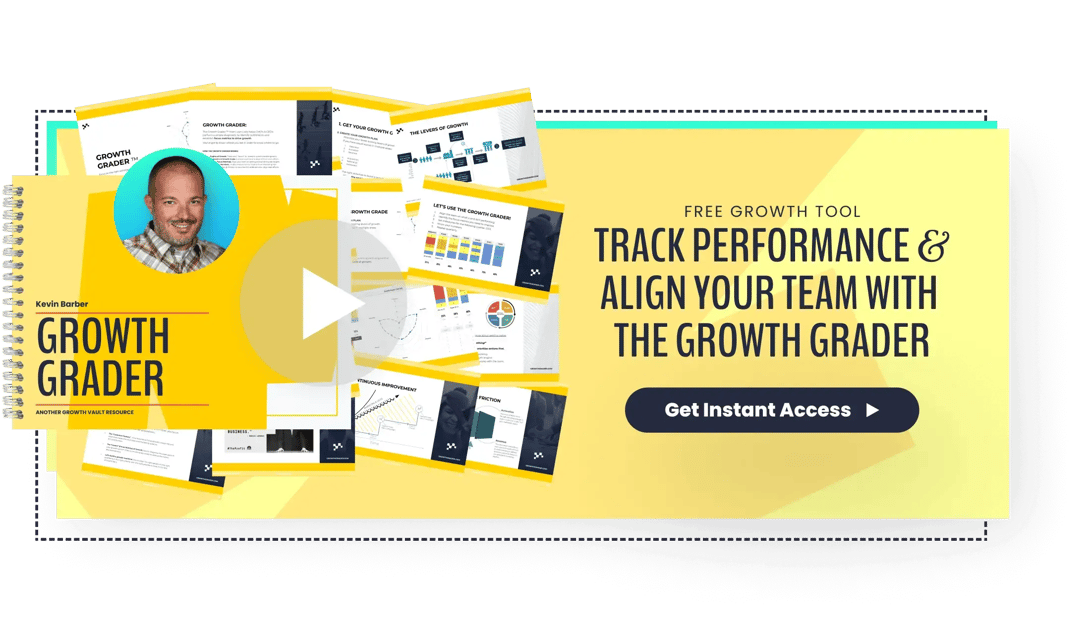6 Common SaaS Sales Problems
- Building awareness
- Profitably acquiring customers
- Activating customers
- Retaining customers
- Multiplying revenue
- Getting referrals
“We got one!”
I still remember the excitement on the CEO’s face as he burst out of his office into the small front room we called the entryway. Well, this was where my desk was, too.
VIDEO TRAINING
Get The Growth Marketing Playbook.
Learn to plan, budget, and accelerate growth with our exclusive video series. You’ll discover:
- The 5 phases of profitable growth
- 12 core assets all high-growth companies have
- Difference between mediocre marketing and meteoric campaigns
Thanks for submitting the form!
We'll review the information you've submitted and respond to you just as soon as possible.
We had four rooms in our small Redmond, WA office. There was the CEO’s office, and then another office for our development team - by "team", I mean one guy who managed a bunch of outsourced developers. And we had a conference room with cheap whiteboards on every wall.
Then, there was my office. I mean, the entryway.
Taped to just about every wall and window were the “flows” -- printed paper showing my funnels for growing this small startup into a huge success.
We closed the doors a month later.
Common SaaS Problems
This is a common story here in the Pacific Northwest. The number of SaaS companies that come and go, burning through capital and never achieving growth is astronomical.
I remember the months leading up to getting our first paying customer. We had tried all kinds of things to get users into the program.
The CEO was on a constant hunt for funding.
We pivoted and tweaked our product a few times, even completely rebranding at one point.
So, why did we close down?
It wasn’t the CEO’s fault. This guy has founded, sold, and exited other startups before. He knew what he was doing.
We had some amazing advisors as well. Every week or so, someone would come in and sit in the conference room, giving feedback on what we were doing and ideas on how we could move the business forward.
Still, a month after getting our first paying customer, I sat across the conference room table from this CEO as he explained we were shutting it all down.
We had a good product.
We had good leadership.
I was doing the marketing, so that area may have been a little suspect.
We also had the same SaaS Sales problems every other SaaS company faces. We just never figured out how to overcome them.
There are six levers that move growth and looking back, I can see where some of our levers were broken. If I could go back in time, I would like to think it would turn out differently. But, who knows?
There is one thing for sure; if you don’t overcome these six problems, you will have a hard time scaling growth to any meaningful measure.

6 SaaS Problems You Must Overcome
SaaS Problem #1: Building Awareness
It’s hard for people to purchase from you if they don’t know you exist. The good news is that it’s never been easier to build brand awareness. I would say 95% of marketing agencies specialize in building brand awareness.
Why?
Because it’s so easy to get your message in front of people.
The problem is, awareness and lead generation don't really matter if your message stinks.
No one cares if you exist, even if they know you do if you can’t help them in some way. And, no one will recognize that you can help them if you can’t communicate it in a way they understand.
The biggest problem SaaS companies have with building awareness is that they don’t know how to stop talking about what they want to talk about, or how to take the consumer's pulse and start talking about what the consumer wants to talk about.
SaaS Problem #2: Profitably Acquiring Customers
For SaaS companies, acquisition is usually automated. In the high-ticket end of the spectrum, you may have actual sales conversations. Either way, the problem is the same.
How do you get someone to pull out their credit card and give you their money?
Even better, how do you get someone to beg you to take their money?
The customer acquisition cost is the critical number. That doesn’t mean leads, that means paying customers.
How much money do you have to spend to acquire a single customer? What do you have to do to lower that amount?
If you can answer those two questions, you are on your way to a winning combination.
Here’s a hint: solving all of these problems will help lower that cost.
SaaS Problem #3: Activating Customers
I bet no one saw this coming back in the dot com boom. But, getting a paying customer to create an account is one thing. Getting them to actually use your software is another.
Here’s the truth: if they don’t use your software, they won’t be customers for long.
I remember applying for a marketing position with a company called Quote Roller back several years ago. They had a problem with activation -- people would sign up for their software, dabble for a little bit, and then abandon them.
Sound familiar?
I told them you have to overcome the pain of change. For their customers, quotes were handled manually with paper and filing cabinets. Their customers were looking for a way to digitize this process. Doing things on paper was getting painful, and their competitors were getting the upper hand.
The problem was, changing to a new system requires, well, change. And change is hard. It hurts.
The truth is, you will never change until the pain of change becomes less than the pain of staying the same.
They had no system to activate their clients and help them reduce the pain of adopting the software. Had they done that, they would have flipped the pain so that the pain of staying the same was greater.
The point is, if you can’t activate your customers and get them using your product, you will not keep customers. And SaaS companies that don’t have recurring revenue, don’t have a business.
SaaS Problem #4: Retaining Customers
So, if you don’t activate customers, you can’t retain them. But, just because you activate doesn’t mean you automatically retain them, either.
The best customers are the ones already in your store, and the most valuable asset SaaS companies have is the people who are already paying them money.
If you’re not listening to them and building features and functionality for them, you’ll lose eventually.
We used to use a tool for content. I won’t say the name of the company. But, it’s still out there and charging customers hundreds of dollars a month.
At first, it was an awesome tool.
However, we soon discovered all kinds of issues with bugs that caused us to look bad for our clients. We would edit a piece of content, send it to the client for review, and two or three days later, when the client looked at it, all the edits were undone.
It was a nightmare.
I spent hours trying to get help, and trying to capture the problem on screengrabs…
Let me say this: if a customer is screaming at the top of their lungs about a bug, and your response is to send the customer on a mission to figure out what causes the bug, the customer is going to get annoyed really quickly.
Long story short, they kept rolling out updates. They changed the fonts. They changed the look and feel of this or that. They had devs working on aesthetics.
We were still having issues that made the software unusable.
We’re no longer paying customers.
If you need inspiration, follow a company called Buffer. They listen, respond to, and care about their customers.
If you look on the homepage of ActiveCampaign, you will see my face and review - at least at the time of this writing. The reason they got a glowing review from me? I asked them about the possibility of a feature we needed that wasn’t available. Three days later, I get a response that tells me to check again, and that feature was there.
Listen to your customers. They will tell you how to be a great company.
Advice from people that aren’t paying you money as customers may be good advice. But it’s less than half as valuable as the advice, requests, and complaints from your paying customers.
SaaS Problem #5: Multiplying Revenue
You may have a SaaS title, but you can and should offer more.
If your app is $20 per month, what can you add on to that to maximize value and charge more?
Happy customers that appreciate your software are highly likely to buy something else from you, especially if it works in concert with the software they are already paying for.
Think about Apple computers and how they work perfectly with the iPad. And, how can you have an iPad and computer and not take advantage of the iPhone? Need to know what time it is? Here’s the Apple Watch.
We call it an ecosystem. Steve Jobs would call it money.
If you can take a $20/mo customer and turn them into a $40/mo customer, you can spend more to acquire that customer.
The one who can spend the most to profitably acquire customers wins. Every single time.
So stack value, and make bigger offers. If you need some practical ways to do this, download our Free Growth Playbook.
SaaS Problem #6: Getting Referrals
If you don’t ask for referrals, you’re just leaving money on the table.
Seriously, you need some kind of system that generates referrals. You can automate it if you want, but it needs to be there.
As I write this, a client of mine received an email from a prospect. How did that prospect come along? An automated referral email we wrote 3 years ago. It went out to a customer, and that customer fired it off to a friend.
Over and over again, it just works.
If you’re throwing thousands of dollars into getting people in the top of your funnel, you need to make sure they aren’t falling to their death at the bottom of the funnel.
Take a portion of your budget, and use it to market for referrals. It’s the easiest sale to make.
Building for Growth
Growth isn’t easy. SaaS problems are hard to solve. When you write a listicle like this, it makes it seem like you can flip a switch and everything be great.
Trust me, I carry the scars of not being able to solve these problems for companies more than once in my career. It’s not always as simple as it sounds.
Every company is different, and every product has its little, unique issues.
However, solving these problems is a must. It will take work, creativity, and sometimes trial and error. But, when you do solve them, growth becomes a byproduct.
Ryan's experience ranges from higher education to SMBs and tech startups. When not doing digital marketing, he's sure to be enjoying some kind of nerdy pastime.






